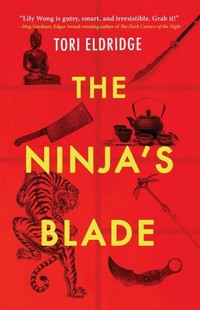 |
The Ninja’s Bladeby Tori Eldridge Paperback, 317 pg. Read: August 4, 2021 |

What’s The Ninja’s Blade About?
I have abandoned this post five times since early August because of this section—I’ve written three that were too detailed (and therefore too long to read) and two that were too vague (and therefore too, well, vague to be any good). So, fine. I give up. Here’s what’s on Eldridge’s website about it:
In THE NINJA’S BLADE, Lily Wong―a Chinese-Norwegian modern-day ninja―has more trouble than she was bargaining for when controlling grandparents arrive in Los Angeles from Hong Kong at the same time she goes undercover in the dangerous world of youth sex trafficking. As she hunts for a kidnapped prostitution victim, a missing high school girl, and a sociopathic trafficker, the surviving members of a murderous street gang hunt for her.
Life would be easier if Lily knew who to trust. But when victims are villains, villains are victims, and even family is plotting against her, easy is not an option. All Lily can do is follow the trail wherever it leads: through a high school campus polarized by racial tension or the secret back rooms of a barber/tattoo/brothel or the soul-crushing stretch of Long Beach Boulevard known as The Blade.
She relies on her ninja skills to deceive and infiltrate, rescue and kill―whatever is necessary to free the girls from their literal and figurative slavery. If only those same skills could keep Lily’s conniving grandparents from hijacking her future.
Words Matter
I could not stop thinking about Robert B. Parker’s Ceremony/Taming a Seahorse/ Hundred-Dollar Baby and any number of similar books by him (and others) featuring P.I.s looking for particular prostitutes. Many of these I’d considered treating the women in question with sensitivity and respect. But I’m starting to think they could’ve done better.
Of course, whatever social workers the P.I.s encountered weren’t the same people Lily encountered. Lily was told in no uncertain terms that it’s not child/teen prostitution, but commercial sexual exploitation, and if she wanted to get anywhere with that agency, she’d adjust her language. Not only is it a language thing—but it reframes the activity. And the criminal culpability of those involved.
You can see its effect on Lily from that point on in the novel, if anything it probably made her more determined.
Lily’s Personal Life
Ask Peter Parker, it’s hard being a vigilante without your family finding out. The Ninja Daughter showed Lily’s skill in keeping that from her family, but it wasn’t easy. Add in trying to date—something Lily hasn’t successfully done since the night her sister died—and you’ve yet another bit of trouble.
Lily finds herself liking Daniel, but can’t make herself make time for him. Until her grandparents intervene, and suddenly, there’s one more plate for Lily to keep spinning.
But the fact that her grandparents are involved in her life is the big thing—they’ve come to visit from Hong Kong to check up on their business. Lily’s mother runs the LA/American branch of the family’s corporation.
Their presence changes—at least temporarily—the dynamic between Lily and her mother. Instead of the fairly antagonistic relationship we saw last time, there’s an alliance of sorts. Lily becomes as much of the supportive, obedient daughter as she can. Her mother’s stress level is through the roof, feeling like every decision she makes and has made—personal and professional—is being weighed and found wanting. So Lily does what she can to take the pressure off—she spends time with them, allows them to meddle in her life (rather than her mom’s), and so on.
I really appreciated this—mutual affection, familial bonds, and so on were present in The Ninja Daughter, but we got to see them in action here. It keeps Ma from being merely an obstacle to Lily’s mission and turns her into a character (that is frequently an inadvertent obstacle to Lily’s mission, sure—but that’s different).
The Fallout From The Ninja Daughter
Lily’s character is defined by her reaction to the trauma and guilt over her sister’s murder. But in The Ninja’s Blade, she has a fresh batch of trauma to deal with. The events of The Ninja Daughter have done some significant damage to her psyche (to paint with a broad brush, Eldridge does a better, and more subtle job of depicting it—don’t let my need for pithiness fool you).
She doubts herself, second-guesses her choices, makes costly errors, and this causes problems for her in the midst of battle (literal or figurative)—and for what Lily’s trying to do, this could be fatal. It’s also making things difficult for her outside of her work.
It’s not like she can seek out a counselor or anything—it’s not like she can tell a lot of people what caused the trauma. So it’s up to Lily—with some help from Stan and Aleisha at the shelter—to work through this.
So, what did I think about The Ninja’s Blade?
Eldridge here takes what was a strong adventure series with heart and a social conscience and improves it here—adding psychological depth, more layers to the protagonist, developing the characters of those around her, and showing that there are real risks and consequences for the protagonist. This isn’t a Reacher-like series, things that happen to Lily matter and will have a lasting impact on the character.
I really enjoyed this book—there’s enough humor and action to make sure this stays entertaining, and the darkness and complexity of the world add weightiness to the novel so that it doesn’t become a disposable thriller.
I strongly recommend this one to you and think it would serve alright as a jumping-on point, but I think you’d be better off jumping back to the prior novel. But starting with this one and then backtracking would work, too. Just do yourself a favor and pick these up.
This post contains an affiliate link. If you purchase from it, I will get a small commission at no additional cost to you. As always, opinions are my own.
![]()


